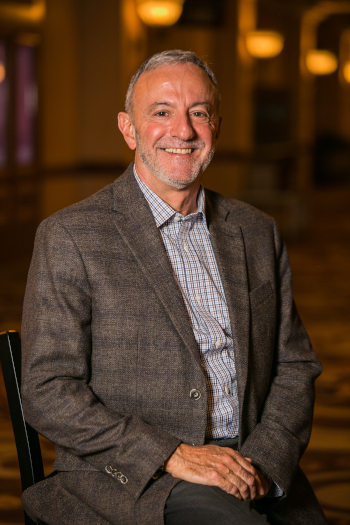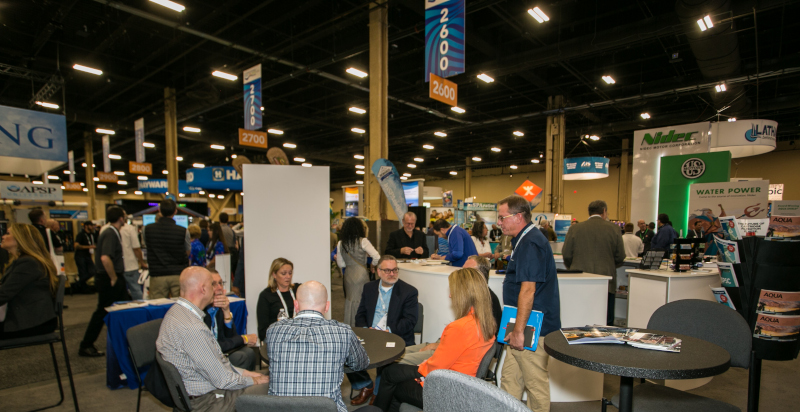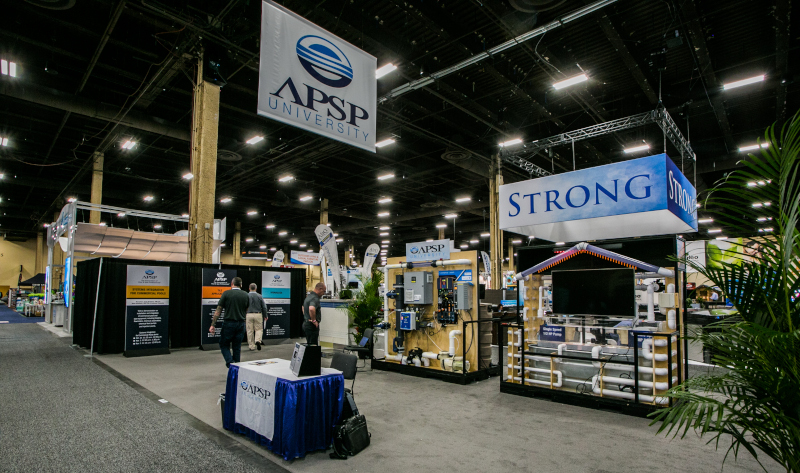The Association of Pool & Spa Professionals
The voice of the industry
Business View Magazine interviews Lawrence Caniglia, President and CEO of APSP, as part of our focus on the pool and spa manufacturing sector.
The Association of Pool & Spa Professionals (APSP) is the world’s oldest and largest association representing swimming pool, spa, and hot tub manufacturers, manufacturers’ agents, builders, designers, distributors, suppliers, installers, retailers, and service technicians. Dedicated to the growth and development of its members’ businesses and to promoting the enjoyment and safety of pools and spas, APSP offers a range of services, from professional development to advancing key legislation and regulation at all levels, to consumer outreach, and public safety. APSP is the only industry organization recognized by the American National Standards Institute to develop and promote national standards for pools, hot tubs, and spas.

Lawrence Caniglia, CEO
“The APSP was originally founded as NSPI, the National Swimming Pool Institute, in 1956,” recounts Lawrence Caniglia, APSP’s President and CEO. “In the early days, back in the ‘50s, a sales scheme, known as ‘bait and switch,’ was used by many disreputable pool dealers. They would advertise one thing, but sell you another. Because this was seen as a rather big issue, several pool company owners got together and formed this organization to combat bait and switch. They came up with a code of ethics, and if you were to become a member of this trade group, you had to agree to the code of ethics, that, although it has been modified over the years, we still adhere to, today. Basically, it was ‘Do no wrong to the consumer.’ Today, the Association is much different, but that early culture of being a reputable dealer and dealing properly with consumers is still very prevalent.”
Today, the APSP has a total membership of 3,200 companies. “If you’re in our industry, it would be the company that is a member of our Association and then all of the staff, workers, and people that work for that company,” says Caniglia. “We don’t count them in our numbers, but they have the same benefits as anybody else in the company. They get the same education member rates, and they can attend different events. We do have associate members; a lot of our pool builders started out as landscapers, who learned how to build pool projects, so they’re associate members. We have some governmental members – regulators, public health officials – because we have people who build and service commercial pools. We have educators, insurance companies, and different groups that look to do business with our members and they become associate members.”
APSP is headquartered in Alexandria, Virginia with 26 local chapters around the country. The Virginia staff of 14 run the education, government relations, standards, membership, and finance departments. “There are four staff members who work remotely,” adds Caniglia. “One is our Western Director on the ground in California, Arizona, and Southern Nevada, working on membership, education issues, and chapter growth. Then I have our Government Relations Director in Florida who handles the entire country. She works on Capitol Hill with our lobbyist (who I do not count as one of our staff). Then, there is my Education Director who lives and works out of Colorado Springs; she travels the world for our education program. I have another Education Department staff member who also works out of Colorado Springs. He’s a full-time contractor who helps develop our new products and does a lot of our technical work online.”
Caniglia says that the head office communicates with the membership via email, a weekly newsletter, and under an agreement with Aqua Magazine, a national trade publication. “We used to publish a quarterly magazine, in-house, and then, a few years ago, we cut a deal with them and they give us so many pages of editorial content,” notes Caniglia. “So, that is actually our flagship publication. We also are the chief sponsor of a national trade show operated by Informa (a multinational events and publishing company), and we just launched a huge online education program. Our education program is all about taking the pool contractor to become a pool professional. And in order to make sure they are professionals, they need the proper training and the proper education to go to that professional step. We spent $1.5 million, last year, upgrading all of our education training programs to make them virtual and interactive.”

Another important function of APSP is writing and promulgating a set of industry standards for the building and servicing of pools and spas. “We are the only nationally-recognized standards writing organization for our industry,” Caniglia states. “We currently have 17 standards and a new code which is called the International Swimming Pool and Spa Construction Code, which was developed in partnership with the ICC, the International Code Council. That was launched in 2012. Right now our code has been adopted in 20 states and 157 jurisdictions around the country, and we’re continuing to build that base to make that one code, the code of the land, so that everybody building a pool is using the same code. And it’s just as important to a manufacturer as it is to the pool builder out in the field, because the pool manufacturer has to know that when they’re manufacturing pumps and heaters and filters and all the different pool components, everybody is following one set of guidelines. And we like to think that when a consumer chooses an APSP member professional to build, service, or maintain their pool, they’re dealing with somebody from a reputable company that adheres to a higher level of standard.”
New trends in the pool and spa industry, according to Caniglia, include more automated controls, more high-tech features, and more pool renovations. “One of the reasons people cite that they don’t want a pool is they’re under the misconception that they’re very expensive to maintain. That’s not false from years past, when we didn’t have the types of automation and controls that we now have. But today, there are robotic pool cleaners, automatic covers, automatic sanitation feeders, and the like. For the pool owner, there’s a lot less they have to think about, and the service technicians can work on their pool, remotely, which also saves time and money.
“Another thing that is real big is the different features now in pools. You have LED lights, which save an enormous amount of energy. They’re very popular and growing all the time. There are water features like spill-over spas, waterfalls, fountains, fire pits – different things we now build with pools to really make them exceptional. We can go from your basic 20X40 family pool in the backyard all the way up to a million dollar pool with the spas and the waterfalls. A lot of that is what’s happening now.
“Then there’s pool renovation. The average life of a pool and its components is 10-15 years. Then you need to replace things like your filter. If you have a vinyl liner pool, your vinyl liner is usually good for 12-15 years. If it’s a gunite pool, it might need a new plaster finish; if it’s a vinyl liner pool, you need a new vinyl liner. But what we’re also seeing is that with automation and the different things you can do with computers to design pools, for not a lot of money, a homeowner can renovate their pools for way less than half the cost of putting in a new one. So, sometimes in the old days, people might have said, ‘Just dig my pool up and fill it in; I don’t really want to go through with the expense.’ Now, they’re seeing that they can renovate it for not a whole lot of money, make it look brand new, and get another 10-15 years out of it. So, renovation has become very large in the industry. It also helped a lot of companies during the recession, when not a lot of new pool building was going on.”

This past January, the Association of Pool & Spa Professionals and the National Swimming Pool Foundation (NSPF) announced that the two organizations will unify to form the Pool & Hot Tub Alliance (PHTA). The new organization will operate with the Pool & Hot Tub Alliance as the umbrella, leading industry-wide advocacy, alliances, and promotions. Trade and foundation activities will be conducted separately for procedural and legal purposes, under the banners of the Pool & Hot Tub Professionals Association, and the Pool & Hot Tub Foundation, respectively. Caniglia, who had earlier told the APSP Board that he planned to retire in February 2019, has agreed to stay on as interim CEO of the consolidated organization until the new Board can hire a full-time, permanent CEO.
The leaders of both NSPF and APSP agreed that the new structure, with its “Celebrate the Water” mission, will offer greater community benefits by facilitating the expansion of swimming, water safety, and related research and outreach activities, aimed at introducing more people to swimming, making swimming environments safer, and keeping pools open to serve communities. In addition, the unified organization will expand growth opportunities for aquatics professionals and businesses by promoting demand for swimming and increasing the efficient delivery of educational and training opportunities.
Finally, by speaking with a single, united, advocacy voice, the Pool & Hot Tub Alliance will be better positioned to protect the interests of the industry through an unprecedented and expanded network that includes both nationwide and international alliances and relationships. In addition, stakeholders and members of the two founding organizations will benefit from the full array of education, training, certification, advocacy, promotion, research, grant making, and support services currently delivered by APSP and NSPF separately, while combining infrastructures, networks, affiliations, and resources, and eliminating duplication of programs to provide the greatest value and impact.
Check out this handpicked feature on MAAX Spas – Built to the MAAX.
AT A GLANCE
WHO: The Association of Pool & Spa Professionals
WHAT: Representing swimming pool, spa, and hot tub manufacturers and associates
WHERE: Alexandria, Virginia
WEBSITE: www.apsp.org


